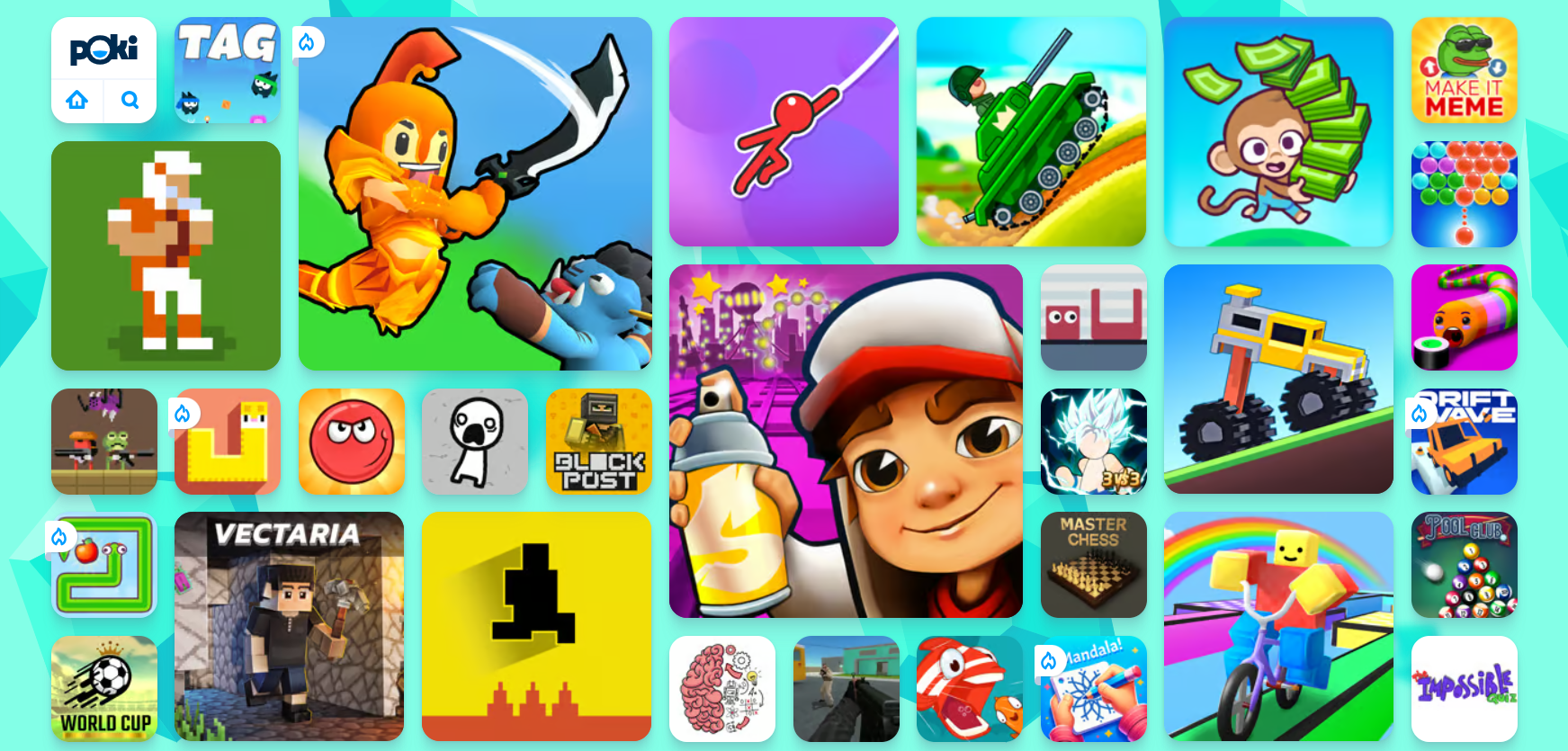Browser Games
Gamification: The trend that converts gamers to bettors

Gamification is the process of incorporating game-like elements and mechanics into a non-game context. It’s intended to increase user engagement, motivation, and participation by making tasks more enjoyable and rewarding.
The process has become increasingly popular across various industries, significantly impacting user engagement and motivation and enhancing performance.
From Android and iOS games to betting websites such top sites by NonGamstopUkCasino, Gamification is present in all forms of entertainment. Loyalty programs, point systems, achievements, and leaderboards are designed to make the overall player experiences more exciting. Gamification is also used to promote responsible gambling by offering tools to keep this activity under control, such as self-exclusion options or the possibility to set deposit and time limits.
As Wikipedia states, Gamification has many benefits, such as increased engagement, improved motivation, and retention. Unfortunately, there are potential drawbacks to consider. These include short-term engagement, lack of interest, unrealistic expectations, overemphasise rewards, and unintended consequences.
What is Gamification?
Gamification uses game design principles to engage and motivate people to participate in an activity or achieve a goal. It is a concept that has gained lots of popularity recently.
Its roots can be traced back to video games. Game designers have used different techniques to create engaging and immersive experiences for players. Elements like points, levels, and rewards are there to keep players engaged and motivated.
The process often involves various elements like game mechanics, rewards and feedback to motivate and engage users. Game mechanics are used to create a sense of achievement and progress and to make tasks more engaging. Rewards motivate players to complete tasks, achieve goals, and participate in activities, while feedback provides information about the users’ progress and performance.
What is Gamification in Gambling?
When it comes to gambling, you can find game-like features and rewards that make traditional casino games more engaging and enjoyable. It’s an approach you’ll encounter at most sites.
One way of implementing Gamification in gambling is through the use of loyalty programs and reward systems. They offer incentives and bonuses for playing, such as free spins, cashback, or VIP status. Players accumulate points or rewards by playing specific games or achieving milestones, which can be redeemed for prizes or other benefits.
Loyalty programs offer rewards, bonuses, and other incentives to players who frequently play games. Players can claim various rewards based on the money they spend, which can be redeemed for prizes and other benefits.
Virtual currencies can be earned through gameplay or purchased with real money and later be used to play certain games or unlock additional features within the casino. On the other hand, leaderboards allow players to compete against each other for prizes or recognition.
Which are the Types of Gamification
If you’re an experienced online casino player, you probably know there are several different types of Gamification in gambling. One of the most widely available types is bonuses. They are offered to gamblers to attract their attention when online and encourage them to join a casino or continue playing. In most cases, these include welcome, deposit, and reload bonuses.
On the other hand, missions represent tasks or objectives that players have to complete to claim rewards. For example, an online casino may invite you to join a mission and play a particular game or make a specific number of bets to unlock a bonus reward. Challenges are similar to missions but often require more involvement from the player’s side, and they can include taking on other players or meeting specific criteria to grab a prize.
Still, bonuses, missions, and challenges have a fair share of advantages and disadvantages.
In addition to being an incentive for new and existing players, bonuses can help increase the bankroll and play for longer. Sometimes, they don’t require a deposit, meaning players can check out a casino without risking their money. The disadvantages include terms and conditions that are hard to meet or expiry dates. Also, players may be required to wager a certain amount before withdrawing their winnings.
Mission offers a clear goal to work towards and can be a fun way of exploring games or casino features. At the same time, completing bonuses can provide rewards. Unfortunately, some missions can take up too much time, frustrating players. Additionally, missions may not appeal to all players.
Challenges are an exciting way to take on other players and provide a competitive experience. They also feature plenty of rewards. However, they can be difficult or require a high level of skill, discouraging and even frustrating players. Once challenges are completed, players may lose interest.
Potential Drawbacks of Gambling Gamification
There are some drawbacks of Gamification in gambling, which according to a study, needs an ethical side. Many criticise this process, as it reportedly encourages excessive gambling. Since Gamification makes gambling more engaging and exciting, players can continue playing online casino games for longer periods, which can negatively impact and lead to problems and addiction.
Also, Gamification is criticised for making gambling appear like a socially acceptable activity. There’s also the issue of transparency and fairness, as the process makes it harder to understand the odds of winning and the rules of the game. Casino operators can utilise Gamification to manipulate the game and swing the odds in their favour.
It can also be misused by making gambling seem more like a game than an activity with real consequences. That’s achieved by incorporating cartoonish graphics, sound effects and other features that create a fun atmosphere.
Additionally, it may impact responsible gambling practices, focusing on rewards rather than consequences. For example, a leaderboard allows players to compete for prizes based on their winnings in a specific timeframe. Hence, it can encourage gamblers to place bets they can’t afford to reach the top and claim a prize.
What are the Ethical Considerations?
Companies can abuse Gamification by using it to manipulate and exploit their customers. They may encourage addictive behaviour or create experiences designed to keep customers coming back, even if it is not in their best interest. It is vital for companies to use Gamification responsibly and transparently, ensuring that it is not being used to deceive or exploit customers. By doing so, they can create engaging experiences that benefit both sides.
Companies should have limits in place to protect their customers from harm. This includes setting maximum limits on bets or deposits, providing tools for customers to monitor their gambling behaviour, and implementing responsible gambling measures. It’s necessary to ensure that customers aren’t at risk of addiction or other negative consequences. Limits can be an effective way to achieve this.
Data modelling and predictive behaviour can enhance Gamification in various industries, including gambling. However, they raise concerns about privacy and potential misuse of personal data. Companies have to use these technologies responsibly and transparently, ensuring that customer privacy is protected and not using predictive behaviour in harmful or exploitative ways. By doing so, they can create engaging experiences while safeguarding the well-being of their customers.
Browser Games
Tips For Beginners For A Successful Start In Genshin Impact

GI is a gacha RPG in which the player independently assembles his own squad of four heroes with the ability to switch between them and goes in search of adventure alone or in the company of friends, but for this you need to level up the adventure level.
Genshin Impact has a cross-platform system – this means that you can play on a PC, phone and tablet with the ability to freely switch. This will help you collect occuli and other resources, but you can always simplify your gameplay and gain adventure ranks using Genshin Impact by professional service Skycoach.

Adventure Ranks
There are no levels in Genshin, but there are ranks – this is the range of your successes in quests and hunts, which open up new gameplay opportunities for you.
You need to constantly progress in adventure levels, at least until you overcome important milestones, after which most of the content will become available to you.
You need to constantly progress in adventure levels, at least until you overcome important milestones, after which most of the content will become available to you.
Follow the quest system to get boosted in Genshin Impact and get to travel level 12, which will unlock daily quests and speed up your character’s further progress.
At level 14, your heroes who are not part of the main squad can be sent on an expedition and over time they will return with resources and food.
At level 16, a multiplayer mode will open for you, in which you can complete quests and destroy monsters in the company of friends, gathering a squad of up to 4 players.
The rating of world loot will increase by 20 and 25 – this means that experience from monsters and the overall chance and value of rewards will be increased.
All rewards can be obtained from the secretary of the travelers guild – Katerina.
Finding her is not difficult, go to Mondstadt and look for her in the eastern part of the map near the exit to the bridge from the city.
Try to complete the storyline as quickly as possible and focus on getting adventure level 25, it will help you quickly collect valuable items that will be useful to you for a long period of time.
The role of oculi in the system of leveling up your character
Oculi are a special accumulative resource that is used as a gift for the statue of the seven archons, which will increase the characteristics you need for the currently selected hero.
For the presented oculi, you can increase your level of endurance, receive travel points, which are equivalent to game levels, exchange for source stones, or one of three seals – geo, electro, or anemo. It is most profitable to change them for seals, or increase your stamina, which will increase your survival.
Adventure experience is of course important to you, but you shouldn’t exchange them for such valuable resources as oculi – you will have many ways to increase your level. It’s better to focus on seals, which are found in limited quantities on game maps, or source stones, which are much more difficult to obtain.
Look for oculi throughout the Genshin Impact area.
There will be a limited number of them, and it is advisable for you to collect them all to significantly strengthen your hero. When you pass by an oculus, you will notice it on the mini-map and receive an audio and visual alert and can collect it.
You will have many chances to collect most of the resources while leveling up and traveling, and interactive maps with their exact locations will help you collect the missing oculi. Also, with the help of cards, you can immediately concentrate your efforts on collecting all the oculi and maximally strengthen your hero to continue boosting in the GI.
Types of oculi
There are three types of oculi in the Genshin territories, and they are distributed in three different territories, and finding them should motivate players to explore the entire island.
- You will begin your collection with Anemocules, of which 66 can be found in the territory of Mondstadt. This is the starting large location where you will spend most of the game time, and you will find most of the oculi naturally.
- Look for Geocules – in the lands of Li Yue, there will already be 133 of them, and although you will find many of them during your travels, some of them will be hidden in hard-to-reach places, and it is better to immediately view them on the interactive map if you want to collect geocules Firstly.
- The last type of resource is Electrocules – and you will find them in Inazuma. But the search will take even longer, because there will be 181 of them scattered around.
You should know that collecting oculi is a good idea for one-time strengthening of your hero and collecting resources, but some of them will not be immediately available and will open only after exploring the zone, or completing a series of quests.
Two ways to make your eye search easier
In Genshin Impact there is a special device called the Echo Stone, it helps to detect the desired type of oculi and for each type there is its own separate stone.
Stones are created using alchemy, but to get this opportunity you need to open a drawing, which is obtained by increasing the reputation of the region. Usually this is the second level and is obtained by completing quests and leveling up in the territory.
Keep in mind that the stone is used to detect the oculi around you and is destroyed after that.
If possible, create a large supply of echo stones, but only use them when necessary, or when you don’t understand exactly where the oculus is located.
In other cases, try using an interactive map to roughly determine the location and then search for them visually.
Activate teleportation points
While gaining travel levels, boosting in GI and exploring territories, you will often have to return to those zones in which you have already been before, and in order not to waste a lot of time moving around, open teleportation points.
Look for small pillars, which will then become teleportation points, which you can activate at any time using the M key, which opens the world map and all zones available for fast travel.
Take the time to find all the teleportation points, especially in locations where you spend too much time finding them and opening them. This is especially true for mountains and swampy locations.

How to strengthen your character
Your level and character strength is calculated by the overall leveling of different heroes, the level of adventures, parameters and characteristics, the strength of weapons and eyeballs, which you already know about.
First of all, you need to form a combat squad of heroes.
You will be able to choose an adventurer who brings more experience, attacking and auxiliary heroes. Each hero can be upgraded using adventure levels, quests and constellations.
Constellations will be obtained when you receive the same heroes, which will allow you to enhance their potential and go through the ascension stage.
At the beginning of your gameplay, try to focus your Genshin boosting on one character that has the potential to level up for yourself and other potential heroes.
Don’t upgrade your weapons at the first stage – it doesn’t make sense, because at the beginning you need to get level 25. The fact is that at levels 20 and 25 you will have a chance to knock out a weapon of the best category, and it is better to improve and pump it up by going through the ascension stage and spending resources. All other weapons will quickly become obsolete and irrelevant, so they are not worth your time.
Collect artifacts – these are important items for which your heroes have 5 slots, which need to be filled. You can increase the strength and endurance parameters, and fill the remaining slots with random parameters and select them according to your requests. If there is not enough health, then endurance, and if attacks, then strength.
You will find artifacts as quest rewards and loot chests, obtained from dungeons and sometimes from NPCs. Remember that NPCs will have the lowest quality items.
You should not pay your attention to increasing the level of artifacts in the first stages, because their value will not be as high as the 3rd level star items, and first get them and then invest them in your artifacts for hero development.
When you assemble your combat squad, focus on the main attacking carry hero, and the rest will help him with healing and strengthening. Start with a hero with travel priority and gradually change it to attack and defense. Constantly collect and update your collections of heroes with the help of prayers until you have assembled the optimal composition of heroes for you.
The article was prepared and written by Skycoach.gg to help newcomers to Genshin Impact.
Browser Games
Bitcoincasino.us Welcomes New Games in Latest Update

It’s an exciting moment for the cryptocurrency gaming industry as innovative bonus buy options make an entrance at a popular destination for digital casino enthusiasts, bitcoincasino.us.
This comes amidst an increasing shift towards cryptocurrency in the procurement of online services and products, particularly where confidentiality, security, and ease of transactions are paramount. The innovative Bonus Buy Options at the Bitcoin Casino are setting new standards in the industry and offering undisputable value to gamers.
Bitcoin Casino US, well-renowned in the iGaming sector, has taken things up a notch by incorporating this unique feature into their platform. This paradigm-shifting initiative is poised to amplify the fun and rewards for players while enhancing their overall gaming experience.
The groundbreaking Bonus Buy feature is a testament to the flexibility and liberal nature of cryptocurrency casinos in comparison to traditional gambling sites. Traditionally, players would have to spend significant amounts of time to unlock bonuses. However, with the unique Bonus Buy feature, this problem is efficiently tackled. It allows players to bypass the usual gaming rounds and straight-up purchase bonus features in specific games.
This kind of innovation only comes naturally to a platform such as bitcoincasino.us that has already carved a unique niche for itself in the cryptocurrency gaming universe. They have been offering an extraordinary array of thrilling games, available to be enjoyed with the privacy and security only Bitcoin currency can provide. Now their innovation continues with the addition of novel Bonus Buy Options.
Let’s delve a little deeper into how this exciting new feature works. Bonus Buy Options allow players to access bonus rounds and special features of certain games instantly, as opposed to having to unlock them through prolonged gameplay. Getting to the bonus stage often requires a level of skill or sheer luck, which may not always be in favor of the player. With this offering, they can essentially shortcut to potentially lucrative bonus rounds for an upfront cost.
This would, of course, cost the player more than a regular spin but the benefits outweigh the costs. Imagine the potential of winning big without having to go through hours of gameplay. It certainly sounds tempting and is alluring enough to catch the attention of novices and seasoned players alike.
The innovative Bonus Buy Options are gaining popularity among players at Bitcoin Casino US. The ability to enter lucrative bonus rounds without the preceding wait and without depending on pure luck is proving to be an appealing feature. More players are seeing the value in paying a bit more to gain instant access to potentially big wins.
All games that have the innovative Bonus Buy feature are suitably marked, allowing players to easily identify which games they can purchase bonuses. Evoking both excitement and curiosity, players have flocked to their gaming roster not just to try the new feature but also to indulge in an ever-expanding collection of games.
The Bitcoin Casino platform represents a new era in online gaming. A platform where users can enjoy high-quality games with the added perks of Bitcoin transactions; earning them the tag of being cryptocurrency gaming forerunner.
The casino prides itself on the gaming liberty it provides to its users. By making the finest gaming options accessible to its players worldwide, it effortlessly manages to transform the online gaming experience into something akin to real-world gambling — within the comfort of your own home.
Not only does Bitcoin Casino US present a vast array of exciting games and opportunities to win, but they also ensure safe and secure transactions using Bitcoin and other cryptocurrencies. They guarantee complete anonymity and transparency to take the hassles out of online gambling and add generous doses of fun and excitement.
The introduction of such innovative features like the Bonus Buy Option is a clear indication of the casino’s commitment to its players”>entertainment. It goes to show that Bitcoin-centric gambling platforms are not just catering to a niche segment but are set on revolutionizing the entire online gaming industry.
hanges in the industry rarely go unnoticed, and innovative alterations such as what Bitcoin Casino US has introduced mark a significant step forward. These advancements show that a subtle shift is happening in the industry, putting the players”>needs at the forefront while adding dimensions of excitement and enjoyment. After all, that’s what gaming is all about!
As the innovative Bonus Buy Options become a norm in the crypto gaming world, it’s clear to see: this is just the beginning of innovative modulations that are set to redefine the landscape of online gaming. Watch this space for more groundbreaking innovations.
Browser Games
Unlocking the Era of Online Casinos: Convenience, Diversity, and Growing Popularity

Gambling has always been a part of human life. After the collapse of the Soviet Union, casinos began to develop in the post-Soviet countries. Initially, they were located in basement-type rooms. Later, elite establishments for the middle and affluent class arose. With the introduction of restrictions in the gambling
business, the popularity of online casinos has increased rapidly. Such Internet resources provide users with a lot of opportunities, which will be discussed later.
Reasons For Popularity
The list of advantages of online casinos over offline establishments is huge. Let’s name the most important advantages:
- Anonymity;
- A wide range of games;
- Availability of bonuses and promotions;
- Efficiency, convenience of depositing/withdrawing funds;
- The opportunity to open a demo account and practice in a demo game.
Registration at the online casino takes a few minutes. By specifying the contact details (sometimes it is required to send a screenshot of the passport), the client gets access to the functionality of the site. He does not need to get to the land-based casino, wait for it to open, or take care of his appearance. Just log into the application (on the website), choose the game you like, and plunge into it with your head, experiencing similar emotions as in a regular casino.
Bonuses and Promotions
In pursuit of a client, companies give virtual users several bonuses. These can be:
an increase in winnings under certain conditions;
- Registration bonus;
- First deposit bonus;
- Bonus for re-replenishment of the account;
- The initial amount to the account;
- Cashback;
- Free spins, etc.
It is worth noting the online casino registration bonus, This is one of the simplest bonuses that are awarded for registration on the online casino website. Also, many online casinos arrange promotions timed to coincide with weekends or holidays. Most of them consist in accruing bonuses and increasing the amount of replenishment of the account. The available promotions can be found in the user’s account. Some companies send relevant notifications to the customer’s email and mobile number.
A Large Variety of Games
Online casinos have the same games as regular establishments. As an example, we can give:
- Roulette;
- Blackjack;
- The wheel of fortune;
- Slot machines.
The accessible interface makes the game process as accessible and comfortable as possible. You can familiarize yourself with the rules of the game on the websites, and if you have any questions, the support service will promptly answer them.
The Possibility of a Demo Game
If you are in doubt about whether it is worth playing at an online casino, or you want to work out one of the strategies, then many companies introduce the demo game option. It is no different from the standard game, with the only caveat that virtual money is at stake. After practicing and mastering the rules, the client decides whether it is advisable to use his financial resources for gambling.
Saving Time
Online casinos are a great alternative to offline establishments. They save time, and access to them is provided from anywhere in the world. To play, it is enough to have a mobile phone (computer, laptop, etc.). Your account and the functionality of the site open after you enter your username and password. It takes a few seconds. After completing a simple set of operations, the online casino client can play without time limits. You can also try to play on different sites of specific different countries, you don’t have to go anywhere. For example, why not try a Greek online casino, to diversify your experience?

Ways to Deposit/Withdraw Funds
Companies offer many options for adding funds to your account, in particular:
- With a VISA/MasterCard bank card;
- In cash via the payment terminal;
- Using various online wallets, etc.
Some online casinos have started accepting cryptocurrency. Withdrawal of funds is usually carried out in the same way as for replenishment.
In conclusion, online casinos are much more convenient, more functional, and more accessible than regular establishments. Their popularity continues to grow along with the development of computer technology. The number of users of such Internet portals is already several million and is gradually increasing.
-

 Guides4 years ago
Guides4 years ago6 Proven Ways to Get more Instagram Likes on your Business Account
-

 Mainstream9 years ago
Mainstream9 years agoBioWare: Mass Effect 4 to Benefit From Dropping Last-Gen, Will Not Share Template With Dragon Age: Inquisition
-

 Guides2 months ago
Guides2 months agoExplore 15 Most Popular Poki Games
-

 Mainstream11 years ago
Mainstream11 years agoNew Assets Found for Half Life Episode 4
-

 Guides1 year ago
Guides1 year agoGan Rubik’s Cube vs. Traditional Rubik’s Cube: Key Differences and Advantages
-
Mainstream14 years ago
How to Fix Modern Warfare 2 Problems/Freezings
-

 Casual5 months ago
Casual5 months ago8 Ways to Fix Over-Extrusion and Under-Extrusion in 3D Printing
-
Guides15 years ago
GTI Club+: Rally Cote d’Azur – PS3 Cheats
